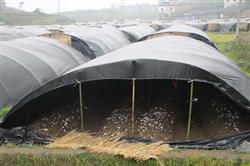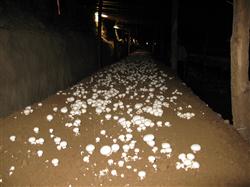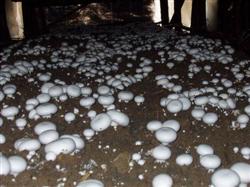How to grow Agaricus bisporus in rice fields?

How to grow Agaricus bisporus in rice fields? Please introduce how to guide the cultivation of Agaricus bisporus in rice field, that is, using rice straw as the main raw material through stacking fermentation as culture material, making use of the temperature and light resources and idle season in autumn, winter and spring, in the paddy field after rice harvest, adopt a planting method of cultivating Agaricus bisporus in open field. In 2005, our county cultivated 300000 square meters of Agaricus bisporus under no-tillage in 12 townships (towns). As of April 15, 2006, the output value per square meter was 18.8 yuan. It is estimated that the output value of the mushroom field will reach 8000 yuan per 667m2, with a net profit of more than 5000 yuan. The main techniques of cultivating Agaricus bisporus in rice field are as follows: first, prepare the mushroom field and choose the formula 1. Generally speaking, the mushroom field should be selected as the mushroom field with high topography, fertile soil, convenient drainage and irrigation, close to water source, good transportation conditions, and no Agaricus bisporus has been planted in 3 years. The rice stump left in the harvest of medium rice or single cropping rice shall not be higher than 10 cm. After the rice harvest is finished, the mushroom field should open the perimeter ditch and waist ditch to drain in advance for use. two。 Mushroom species selection at present, the main varieties of Agaricus bisporus cultivated in our county are "2796" and "Zhenong 1", both of which belong to medium and low temperature varieties with good quality and high yield. 3. The selection of reasonable formula is beneficial to improve the yield and quality of Agaricus bisporus. The proportion of ingredients is one of the key factors affecting the high quality and high yield of Agaricus bisporus. The formulas used by most mushroom farmers in our county are as follows, which can be selected according to local conditions and local materials (calculated according to the actual area of 400 square meters of Agaricus bisporus cultivated in 667 square meters of paddy field). Formula 1: 6000 kg of dried straw, 400kg of vegetable cake, 100kg of phosphate fertilizer, 60kg of urea, 200kg ~ 250kg of lime, 150kg of gypsum and 150kg of special fertilizer for Agaricus bisporus. Formula 2: 5000 kg of dried rice straw, 2000 kg of dried cow dung, 40kg of urea, 200kg of lime, 150kg of gypsum and 100kg of special fertilizer for Agaricus bisporus. Second, preparing the raw materials and arranging the production season reasonably are the important prerequisites for the high yield of Agaricus bisporus. The suitable cultivation time should be determined according to the climatic conditions, especially the temperature conditions. Our county usually has dry straw, dried cow dung and vegetable cakes and other culture materials before the middle of August. The temperature is too high in early cultivation and too low after the end of September, which is not conducive to the high yield of Agaricus bisporus. 1. The selection and preparation of culture materials must be able to meet a variety of nutrients needed for the whole growth and development of Agaricus bisporus. The culture material must have three elements: first, the carbon and nitrogen materials must be sufficient (according to the experiment, the C / N ratio of the culture material is 30 ∶ 1 before the batch fermentation, and the C / N ratio should reach 17: 18 ∶ 1 after the fermentation of the culture material), and the contents of nutrients such as phosphorus, potassium, calcium and sulfur should be suitable. Second, the material texture of the culture material should be loose, elastic and can contain more air to meet the needs of mycelium respiration and aerobic microbial decomposition of culture materials. Third, it should have the ability of heating to promote the fermentation of culture materials and eliminate germs and pests by high temperature. Livestock manure is rich in nutrients needed by Agaricus bisporus, and its calorific value is high, so it is a good culture material for growing Agaricus bisporus. The content of nitrogen, phosphorus and potassium in pig manure is high, but the content of organic matter is low. Using pig manure as heap material, the mushroom can be produced quickly, but the mushroom is dense, the mushroom body is small, the quality is poor, and the yield is higher in the early stage and lower in the later stage. The contents of organic matter, nitrogen, phosphorus and potassium in cow manure are high, which can meet the growth needs of Agaricus bisporus. However, if wet cow dung is used, the wet dung contains more water, the tissue is fine, the fermentation is slow, the temperature in the pile is lower, and the bacteria are not ideal. If the cow dung is dried and crushed, the fermentation is fast, the temperature in the pile is high, the body of Agaricus bisporus is strong, the quality is good, and the mushroom production period is longer. The yield and quality of Agaricus bisporus cultivated with horse dung was similar to that cultivated with cow dung. Therefore, pig manure, cow manure and horse manure can be used as culture materials, it is best to mix several kinds of animal manure, the effect is better. Chicken manure and duck manure have sufficient nutrients, fast fever and high temperature, but they are alkaline and viscous, so they can be mixed with animal manure. Fourth, strengthen fertilizer and water management of Agaricus bisporus spray water? Then: give priority to the moist soil layer, that is, pinch flat to round, not stick to the hand is appropriate; dry in winter should not be wet, spring should not be wet. Eight taboos of spraying water on Agaricus bisporus: first, high temperature spraying; second, spraying water before picking mushrooms; third, spraying too much water on weak mycelium; fourth, spraying high concentration fertilizer and agricultural medicine; fifth, spraying too much water when it rains; sixth, using ladle to splash water; seven, not spraying water; eight bogeys spraying water is not ventilated. The amount of water sprayed per square meter of mushroom bed should not exceed 1.5 kg. 1. Timely spray water ① mushroom water. When the mycelium grows to 4 / 5 of the soil layer (about 10 days after the soil is covered), that is, the villi hyphae form a line at 1 cm from the soil surface, and kink ball white spots appear, re-spray water once, and spray 4 times with 1 kg of water per square meter of mushroom bed. ② mushroom water. About 3 days after stopping the mushroom water, that is, about 14 days after covering the soil, the small white dots in the soil layer turned into fleshy round and hard small mushroom buds, which generally grew to the size of mung beans or soybeans, with 0.5 kg of water per square meter of mushroom bed. Spray 4 times, spray water for 5 to 10 minutes and cover the grass curtain. The temperature must be lower than 18 ℃ when spraying water. ③ turns the tide. After each Pleurotus ostreatus was harvested, the mushroom bed was sprayed with 0.5 kg water per square meter (1 kg ~ 1.5 kg water per square meter). two。 Ten days after the soil was covered with nutrient solution, the mushroom high yield hormone No. 1 was sprayed once combined with mushroom water. About 14 days after soil mulching, the mushroom high yield No. 2 was sprayed with mushroom water once. At the stage of mycelial kink and budding, mushroom high yield No. 3 was sprayed once, and mushroom high yield No. 4 was sprayed once about 7 days after mushroom was produced in a large area. Mushroom bed No. 5 was sprayed with mushroom high yield hormone to adjust the pH of the chamber surface once in the rest stage to maintain the vitality of the mycelium. Click to get more mushroom planting techniques click to get more edible mushroom cultivation techniques
- Prev

How to grow Agaricus bisporus?
How to grow Agaricus bisporus? Please introduce Agaricus bisporus, also known as Agaricus bisporus, Agaricus bisporus, which is the first large edible mushroom in the world. The nutritional value of mushroom is very high. At present, it is developing very fast, growing at a rate of 15% to 20% a year. Agaricus bisporus is a straw rot fungus, medium-and low-temperature mushrooms, rice straw and wheat in the north.
- Next

How to use water to grow Agaricus bisporus?
How to use water to grow Agaricus bisporus? Please guide the production of Agaricus bisporus from covering soil to mushroom, in addition to routine water use and moisturizing management, correctly grasp and apply the following four key points of water use, to ensure the number and vitality of mycelium, to ensure the consistency of buds and buds, and to ensure the healthy growth of fruiting bodies.
Related
- Fuxing push coffee new agricultural production and marketing class: lack of small-scale processing plants
- Jujube rice field leisure farm deep ploughing Yilan for five years to create a space for organic food and play
- Nongyu Farm-A trial of organic papaya for brave women with advanced technology
- Four points for attention in the prevention and control of diseases and insect pests of edible fungi
- How to add nutrient solution to Edible Fungi
- Is there any good way to control edible fungus mites?
- Open Inoculation Technology of Edible Fungi
- Is there any clever way to use fertilizer for edible fungus in winter?
- What agents are used to kill the pathogens of edible fungi in the mushroom shed?
- Rapid drying of Edible Fungi

